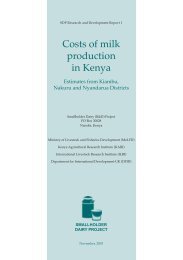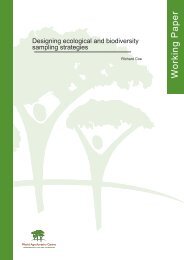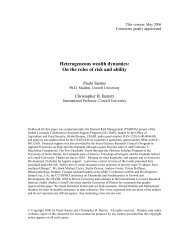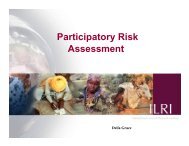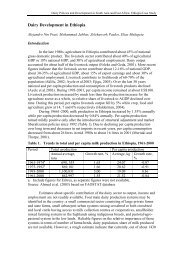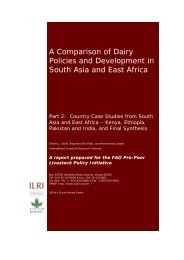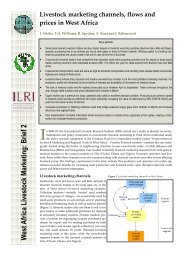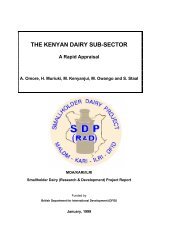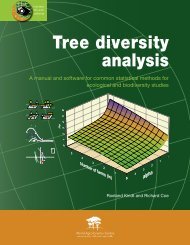<strong>Animal</strong> resourcesBuffaloes are ma<strong>in</strong>ly concentrated <strong>in</strong> the prov<strong>in</strong>ces <strong>of</strong> Pangas<strong>in</strong>an (Ilocos region), Cagayan and Isabela(Cagayan Valley region), Nueva Ecija (central Luzon region), Quezon (southern Tagalog region), Iloilo(western Visayas region), Bohol (central Visayas region) and Leyte (eastern Visayas region). However, <strong>in</strong>these areas there has been a marked reduction <strong>in</strong> their numbers. On the other hand, <strong>in</strong> the western and centralM<strong>in</strong>danao regions, where there are relatively low concentrations <strong>of</strong> buffaloes, the numbers have <strong>in</strong>creased.Shortages <strong>in</strong> the domestic beef market and the correspond<strong>in</strong>g high prices have also encouraged the <strong>in</strong>creasedslaughter <strong>of</strong> buffaloes. The slaughter-ban imposed on buffaloes has done little to reverse this trend.Almost all (99%) <strong>of</strong> the 2.7 million buffaloes are kept amongst smallholders for draft purposes and meatproduction. Large numbers <strong>of</strong> buffaloes are used for transport<strong>in</strong>g sugar-cane <strong>in</strong> the western and centralVisayas regions, and for transport<strong>in</strong>g coconuts <strong>in</strong> the prov<strong>in</strong>ces <strong>of</strong> Quezon (southern Tagalog region),Camar<strong>in</strong>es Sur (Bicol region), Leyte (eastern Visayas region) and on parts <strong>of</strong> the M<strong>in</strong>danao island group.Equally, large numbers <strong>of</strong> buffaloes are found <strong>in</strong> the graz<strong>in</strong>g lands <strong>of</strong> Masbate Prov<strong>in</strong>ce (Bicol region) wherethey are an important source <strong>of</strong> draft power and meat for the Manila market. From 1982 to 1992, the UnitedNations Development Programme provided f<strong>in</strong>ancial support for improvement programmes to <strong>in</strong>crease milkproduction, body size and draft capacity <strong>in</strong> swamp buffaloes through upgrad<strong>in</strong>g with river<strong>in</strong>e breeds fromsouth Asia, notably the Murrah and the Nilli-Ravi. An estimated 8000 crossbreds are now <strong>in</strong> use, ma<strong>in</strong>ly <strong>in</strong>the Cagayan Valley, central Luzon and northern M<strong>in</strong>danao regions.Cattle are distributed amongst the three ma<strong>in</strong> island groups <strong>of</strong> Luzon (47%), M<strong>in</strong>danao (31%) andVisayas (22%). The high extraction rate and the decl<strong>in</strong>e <strong>of</strong> cattle production <strong>in</strong> the ranch<strong>in</strong>g sub-sector hasled to a higher reduction <strong>in</strong> cattle numbers than for buffaloes <strong>in</strong> most areas <strong>of</strong> the country, except <strong>in</strong> the Ilocosregion <strong>in</strong> the Luzon island group and most regions <strong>of</strong> the M<strong>in</strong>danao island group. Over 90% <strong>of</strong> the cattlepopulation are kept by smallholders. The greatest concentrations <strong>of</strong> smallholder cow–calf operations arefound <strong>in</strong> the prov<strong>in</strong>ces <strong>of</strong> Pangas<strong>in</strong>an (Ilocos region), Cagayan (Cagayan Valley region), Palawan (southernTagalog region), Bukidnon (northern M<strong>in</strong>danao region), and south Cotabato (southern M<strong>in</strong>danao region).Native breeds and grade cattle <strong>of</strong> Brahman or European orig<strong>in</strong> predom<strong>in</strong>ate. The ma<strong>in</strong> cattle-fatten<strong>in</strong>goperations are found <strong>in</strong> the prov<strong>in</strong>ces <strong>of</strong> Batangas (southern Tagalog region), Cebu (central Visayas region),Bukidnon and Misamis Oriental (northern M<strong>in</strong>danao region) and south Cotabato (southern M<strong>in</strong>danao region).Most animals for fatten<strong>in</strong>g are crossbreds.Goats are distributed across the island groups <strong>of</strong> M<strong>in</strong>danao (38%), Luzon (33%) and Visayas (29%). Goats<strong>in</strong> the M<strong>in</strong>danao and Visayas island groups have recorded consistently positive annual growth rates. In manyprov<strong>in</strong>ces <strong>in</strong> these regions, the expansion <strong>in</strong> goat populations was associated with <strong>in</strong>creased production to meetthe demand for meat. Goat production <strong>in</strong> many areas has expanded with the <strong>in</strong>troduction <strong>of</strong> auction markets andloan projects. Rapid decreases <strong>in</strong> goat populations <strong>in</strong> Benguer Prov<strong>in</strong>ce (Ilocos region) have been associatedwith <strong>in</strong>creased vegetable production. In other prov<strong>in</strong>ces such as Abra (Ilocos region), Oriental M<strong>in</strong>doro andQuezon (southern Tagalog region) the negative growth rates are associated with <strong>in</strong>creased <strong>of</strong>ftakes.Sheep are found <strong>in</strong> pockets throughout the country, such as <strong>in</strong> the prov<strong>in</strong>ces <strong>of</strong> Negros Occidental(western Visayas region) and Davao del Sur (southern M<strong>in</strong>danao region) (PCARRD 1988). In recent years,there has been an <strong>in</strong>creas<strong>in</strong>g tendency, ma<strong>in</strong>ly by the private sector and non-government organisations, toimport sheep from overseas. These have <strong>in</strong>cluded breeds from Australia, India and the USA.Pig production is common <strong>in</strong> all regions <strong>of</strong> the country. Although production has decl<strong>in</strong>ed <strong>in</strong> the Visayasand M<strong>in</strong>danao island groups, there has been significant expansion on the Luzon island group, notably <strong>in</strong>Bulacan Prov<strong>in</strong>ce (Ilocos region) as well as <strong>in</strong> Rizal, Palawan and Cavite prov<strong>in</strong>ces <strong>in</strong> the Cagayan Valleyregion. Increased pig production <strong>in</strong> these prov<strong>in</strong>ces is associated with the growth <strong>of</strong> commercial operationsand the development <strong>of</strong> co-operatives.Chicken are distributed widely <strong>in</strong> the three ma<strong>in</strong> island groups <strong>of</strong> Luzon (55%), Visayas (25%) andM<strong>in</strong>danao (20%). High populations <strong>of</strong> chicken are found <strong>in</strong> the regions <strong>of</strong> central Luzon, southern Tagalog,western Visayas, central Visayas and southern M<strong>in</strong>danao. Both hybrid and native chicken are used; the meatand eggs be<strong>in</strong>g very important for household consumption and <strong>in</strong>come generation. Duck production is
ga<strong>in</strong><strong>in</strong>g <strong>in</strong> importance, and significant expansion has occurred <strong>in</strong> the Luzon and Visayas island groups. LagunaProv<strong>in</strong>ce (southern Tagalog region) has the largest population <strong>of</strong> ducks.<strong>Animal</strong> production systemsRum<strong>in</strong>ants are associated with annual food crop and perennial tree crop systems. Stall-feed<strong>in</strong>g, tether<strong>in</strong>g andfree graz<strong>in</strong>g are practised <strong>in</strong> the Philipp<strong>in</strong>es. In 1993, about 8.5% <strong>of</strong> the total cattle population was found <strong>in</strong>the commercial sector <strong>in</strong> <strong>in</strong>tensive systems such as feedlots. The share <strong>of</strong> this sector has decl<strong>in</strong>ed from about11% <strong>in</strong> the early 1980s due to security problems, uncerta<strong>in</strong>ty associated with the Comprehensive AgrarianLand Reform Law, and a lack <strong>of</strong> long-term credit. However, these factors have also provoked a structuralshift from ranch<strong>in</strong>g systems to feedlot operations.There are three ma<strong>in</strong> production systems for pigs. The smallholder system us<strong>in</strong>g native and crossbredanimals, the smallholder semi-commercial system us<strong>in</strong>g improved breeds, and the <strong>in</strong>tensive commercialsystem us<strong>in</strong>g improved breeds, high-quality concentrate feeds and disease-control measures. Traditionalsmallholder production <strong>in</strong>volves scavenger systems associated with the feed<strong>in</strong>g <strong>of</strong> root crops, householdwaste and the limited use <strong>of</strong> concentrates. Pigs are sometimes associated with rice and aquaculture.Although chicken are widespread <strong>in</strong> scavenger systems, semi-<strong>in</strong>tensive smallholder production (up to500 layers or 1000 broilers) is expand<strong>in</strong>g rapidly, especially <strong>in</strong> the regions <strong>of</strong> western Visayas and western,northern and central M<strong>in</strong>danao. Intensive commercial chicken production is very advanced and is based onthe availability <strong>of</strong> hybrid breeds, the use <strong>of</strong> concentrate feeds based on maize and soyabean, and the use <strong>of</strong>vacc<strong>in</strong>es and drugs to control diseases. Ducks are raised ma<strong>in</strong>ly <strong>in</strong> smallholder systems <strong>in</strong> flooded rice fieldsand fed household wastes and limited concentrates. Intensive production <strong>in</strong> more conf<strong>in</strong>ed systems, whererations consist <strong>of</strong> rice bran and soyabean meal, is on the decl<strong>in</strong>e. A system not adequately developed is the<strong>in</strong>tegration <strong>of</strong> ducks with fish and vegetables.Feed resourcesFeed resources for rum<strong>in</strong>ants are abundant. Native pastures are available on roadsides, on wasteland, <strong>in</strong> uplandareas deforested by shift<strong>in</strong>g cultivation, and under perennial tree crops such as the coconut. The native grassesare <strong>of</strong> poor quality and generally support low carry<strong>in</strong>g capacities, approximately 0.17–0.33 rum<strong>in</strong>ant units(RU)/ha (one RU for buffaloes = 1.0; cattle = 0.8; small rum<strong>in</strong>ants = 0.1). <strong>Systems</strong> such as tether<strong>in</strong>g and stallfeed<strong>in</strong>g may limit roughage <strong>in</strong>take <strong>in</strong> rum<strong>in</strong>ants for different reasons. The diverse cropp<strong>in</strong>g patterns generatea wide range <strong>of</strong> crop residues and AIBP. Sevilla (1994) has estimated that there is a total feed balance <strong>of</strong> 4.9t <strong>of</strong> dry matter per RU <strong>in</strong> the Philipp<strong>in</strong>es, which could support an additional 11.3 million RU <strong>of</strong> cattle,buffaloes and small rum<strong>in</strong>ants.There is considerable potential to further utilise the vegetation under perennial tree crops such as thecoconut. The <strong>in</strong>tegration <strong>of</strong> small rum<strong>in</strong>ants with the coconut is arguably the easiest because <strong>of</strong> m<strong>in</strong>imaldisruption to the management <strong>of</strong> the crop and the smaller fluctuations <strong>in</strong> the availability <strong>of</strong> herbage over timethrough shad<strong>in</strong>g.<strong>Animal</strong> health and diseasesDiseases occurr<strong>in</strong>g <strong>in</strong> the Philipp<strong>in</strong>es are listed by Campbell (1992). The most important health problems forcattle and buffaloes are foot-and-mouth disease, haemorrhagic septicaemia and anthrax. The former is a majorlimitation for smallholders who depend on the use <strong>of</strong> draft power for land preparation and haulage. Parasiticdiseases that occur <strong>in</strong> rum<strong>in</strong>ants <strong>in</strong>clude anaplasmosis, babesiosis, trypanosomiasis and fascioliasis.Foot-and-mouth disease also occurs <strong>in</strong> pigs, but may be less important for smallholders as the numbersproduced per farm are low although, overall, such systems account for 83% <strong>of</strong> total pig numbers. However,foot-and-mouth disease <strong>in</strong> pigs can be transmitted to large rum<strong>in</strong>ants. The mortality <strong>of</strong> beef cattle <strong>in</strong>smallholder systems is relatively high (10–60% compared to 0.6% for commercial herds).Vacc<strong>in</strong>ation <strong>of</strong>poultry aga<strong>in</strong>st Newcastle disease is not practised at the smallholder level and high mortality rates haveresulted from outbreaks <strong>of</strong> the disease.
- Page 2 and 3:
Affiliation of Authors:Dr C. Devend
- Page 4 and 5:
6.Strategyfor researchJustification
- Page 7 and 8:
AcknowledgementsThe International L
- Page 9 and 10:
esearch opportunities appropriate t
- Page 11 and 12:
Table 1.Animal populations and meat
- Page 13 and 14:
Introduction2. Characterisation and
- Page 15 and 16:
Figure 2. Sub-humid tropics and sub
- Page 17 and 18:
Table 3.Human and animal population
- Page 19 and 20:
Table 5. Rice-growing environments
- Page 21 and 22:
Multiple upland annual crop systems
- Page 23 and 24:
Table 6. Continued.Country Importan
- Page 25 and 26:
It should be noted that, compared w
- Page 27 and 28:
Table 8.CountryCambodiaChinaIndones
- Page 29 and 30:
of non-renewable fossil fuels and t
- Page 31 and 32: Overview of researchThere was a sur
- Page 33 and 34: • Identification of alternative c
- Page 35 and 36: Various animal production systems t
- Page 37 and 38: Presently, much of the vegetable pr
- Page 39 and 40: Table 10. Summary of the main socio
- Page 41 and 42: Table 11. Institutions and organisa
- Page 43 and 44: 3. In the ASEAN sub-region, inadequ
- Page 45 and 46: Table 12. Continued.SituationsPract
- Page 47 and 48: 6. Strategy for researchJustificati
- Page 49 and 50: Table 13. Priorities for research a
- Page 51 and 52: VietnamResearch capacity in NARS is
- Page 53 and 54: CRIFC (Central Research Institute f
- Page 55 and 56: IAS. 1995. Proceedings of the Works
- Page 57 and 58: Systems of sub-Saharan Africa. Volu
- Page 59 and 60: or waterlogged in the wet season an
- Page 61 and 62: Table A1. Important diseases of ani
- Page 63 and 64: • Increased cropping intensities,
- Page 65 and 66: the animal output came from pigs al
- Page 67 and 68: 18-21° North, with an average rain
- Page 69 and 70: In the Nusa Tenggara islands, signi
- Page 71 and 72: Women work 11.5 h/day on average co
- Page 73 and 74: Various Australian forage projects
- Page 75 and 76: village production systems; to stud
- Page 77 and 78: The availability of feed in rubber
- Page 79 and 80: of the Ayeyarwady and Sittang river
- Page 81: Constraints and opportunitiesInadeq
- Page 85 and 86: Table A3. Characterisation of crop-
- Page 87 and 88: Table A4. Interventions in crop-ani
- Page 89 and 90: Table A4. Continued.Project TitleGo
- Page 91 and 92: otations are practised, and there a
- Page 93 and 94: such as abortion. Vaccination cover
- Page 95 and 96: large areas of forests (3.4 million
- Page 97 and 98: Table A6. Some animal diseases repo
- Page 99 and 100: Appendix IIItineraryThe Philippines
- Page 101 and 102: 26 November 1996 am Visit to small
- Page 103 and 104: Appendix IIIList of persons metPhil
- Page 105 and 106: Mr Chhiv Nan, Acting Director, Depa
- Page 107 and 108: Dr U Maung Ngint, Managing Director
- Page 109: List of acronymsAARDACIARADBAEZAIBP



